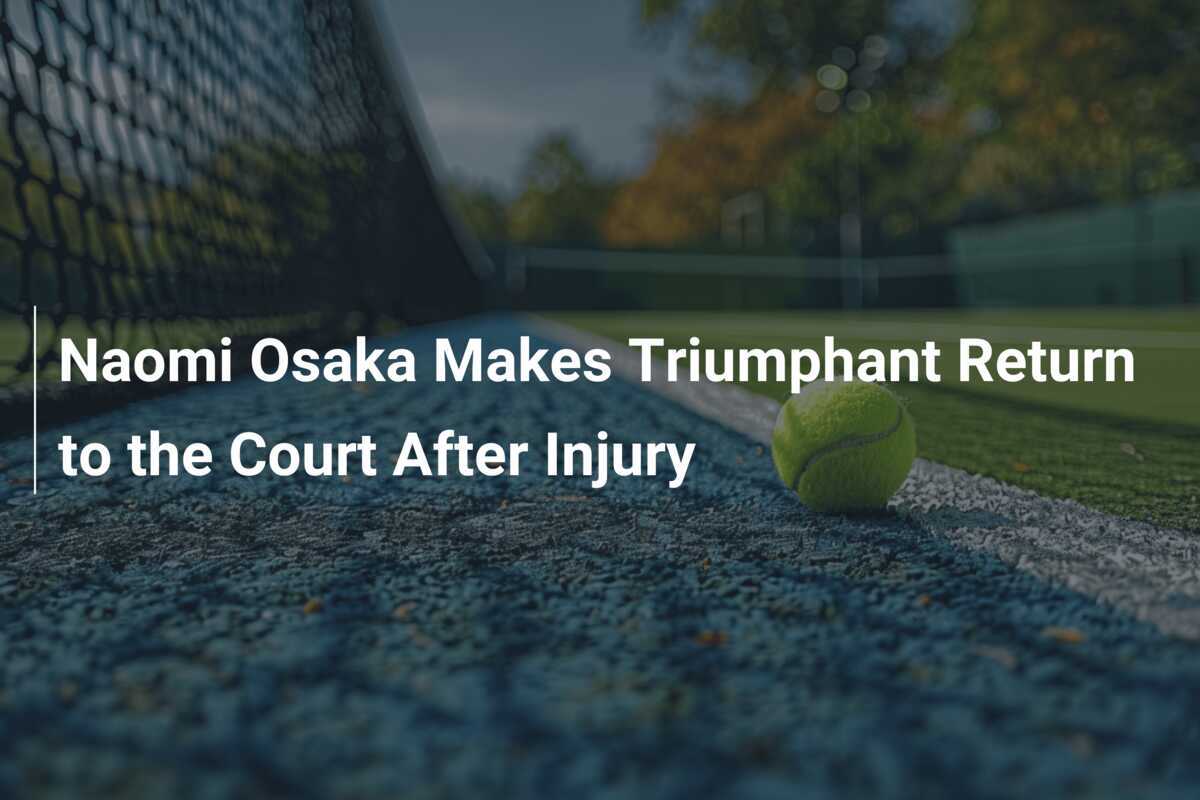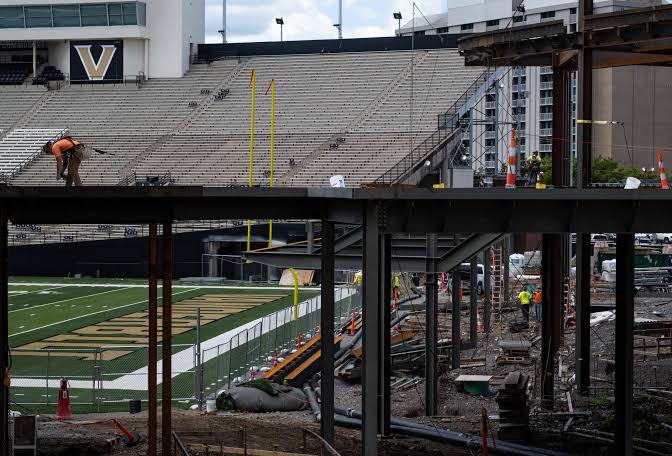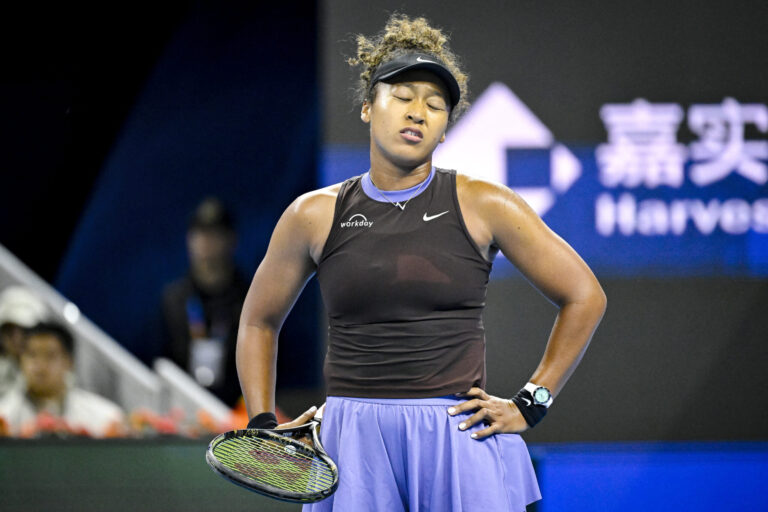
Naomi Osaka’s Comeback: A New Chapter at the ASB Classic Following a Back Injury
The story of Naomi Osaka’s career has been one of remarkable highs, unexpected lows, and an unwavering determination to rise above the challenges she faces. Known for her grace, power, and mental resilience on the tennis court, Osaka quickly became one of the most recognized and beloved athletes of her generation. But after achieving significant success early in her career—including winning multiple Grand Slam titles—Osaka faced a series of setbacks, including injuries, mental health struggles, and personal reflection.
In 2024, after two months away from the court, Osaka returned to the tennis world at the ASB Classic in Auckland, a WTA 250 event. This marked her first competitive match since recovering from a back injury that had forced her to step away from the game. The comeback was eagerly anticipated by fans, analysts, and fellow players alike, all wondering how the 26-year-old would handle her return to the court after an extended break. Would she recapture her former form, or would the pressures and challenges of her past still weigh on her performance?
In this article, we will explore Naomi Osaka’s return to tennis, how she managed her injury recovery, what her performance at the ASB Classic revealed, and what it means for her future in the sport. We will also delve into the broader context of Osaka’s journey, reflecting on her growth as a player and individual, and how this comeback signifies more than just a return to the game—it marks a new chapter in a career that continues to evolve.
Osaka’s Injury Struggles: A Setback That Led to Reflection
Osaka’s decision to take a break from tennis for several months in 2024 was not taken lightly. The back injury she sustained earlier in the year had sidelined her for two months, forcing her to reassess her priorities and approach to the sport. Back injuries, in particular, are tricky for tennis players as they impact a player’s power, movement, and overall ability to perform at the highest level. For Osaka, whose game relies on her ability to generate explosive power from the baseline, any injury to her back was particularly worrisome.
But Osaka did not let this setback define her. Instead, she saw it as an opportunity to reflect and recharge. Taking time off from the sport allowed her to focus on her physical rehabilitation and mental well-being. In her break, Osaka found herself re-evaluating not only her physical condition but also her relationship with the sport itself. Over the years, she had become one of the most prominent figures in tennis, and the pressure to constantly perform had begun to take a toll. The injury forced her to step away from the court, which she later admitted was both frustrating and enlightening.
Through this period of reflection, Osaka began to understand that taking care of her body and mind was just as important—if not more so—than her success on the court. By stepping back and focusing on recovery, she gained a new perspective on her career and realized that tennis, like life, is about resilience, recovery, and growth, not just about winning.
The ASB Classic: A Fresh Start for Naomi Osaka
When Osaka finally made her return to competitive tennis in 2025, it was at the ASB Classic in Auckland, a WTA 250 event. This tournament was significant in many ways. First and foremost, it was Osaka’s first appearance after her back injury, and it marked the first opportunity for her to test her recovery on the court against live competition. Additionally, the ASB Classic was a perfect venue for a low-pressure return, offering a chance for Osaka to ease back into competitive tennis while also preparing for the larger challenges ahead.
The ASB Classic is a warm-up event for the Australian Open, and its location in Auckland provided a friendly and welcoming atmosphere for players, making it an ideal environment for a comeback. It offered a mix of both seasoned players and rising stars, and while the tournament is not a prestigious Grand Slam, it is highly competitive in its own right. For Osaka, it was an opportunity to gauge her physical readiness and see how well she could match up against her peers after an extended break from the game.
Osaka’s performance at the ASB Classic quickly became a topic of great interest. As she stepped back onto the court, all eyes were on her: Would she be able to pick up where she left off? Could she showcase the same powerful game that had earned her Grand Slam victories? And, perhaps most importantly, would she find joy in competing again after such a long hiatus?
Osaka’s Performance: Signs of Improvement and Future Potential
Naomi Osaka’s first match at the ASB Classic was highly anticipated, and despite the break and recovery from her back injury, she showed promising signs of her potential return to the top levels of tennis. While she didn’t claim the championship title, her performance demonstrated that she still had all the tools to compete at a high level.
Osaka’s serve, one of her greatest weapons, was powerful and precise, though it took some time for her to fully regain her rhythm after months away from competitive play. Her forehand, known for its speed and precision, was also a key weapon throughout the tournament. However, it was clear that Osaka was still shaking off some rust, particularly in longer rallies and when faced with opponents who could dictate the pace of the match. Her movement around the court, a key part of her game, was also noticeably cautious early on, as she worked through the physical limitations of her injury.
Nevertheless, there were glimpses of her former dominance. In her matches, Osaka displayed moments of brilliance, flashing the same powerful strokes that helped her secure Grand Slam victories in the past. Her confidence was slowly returning as the tournament progressed, and with each match, she seemed to get stronger, both physically and mentally. The key takeaway from her ASB Classic performance was not necessarily her victories or losses, but rather the fact that she had returned to the game with a renewed sense of purpose.
The ASB Classic was not without its challenges. Osaka had to face some formidable opponents, including rising stars and established players who had been in competitive form for much of the season. While she was eliminated before the final rounds, her early matches showed that, despite her time away, Osaka could still compete with the best.
One of the most notable aspects of her return was her attitude on the court. Gone was the sense of frustration and pressure that had plagued her in recent years. Instead, she seemed to embrace the joy of playing, focusing on enjoying the process of competing rather than obsessing over outcomes. Her mental and emotional growth, which had been a key theme in 2024, was evident in how she handled the inevitable ups and downs of the tournament.
Off-Court Growth: Embracing Mental Resilience
Throughout her time off from the sport and during her comeback at the ASB Classic, Osaka continued to embrace her journey toward mental well-being. Mental health has been one of the central themes in Osaka’s career, and the athlete has been vocal about the pressures that accompany being in the spotlight. In recent years, she made a conscious effort to speak out about her struggles with anxiety, depression, and the toll of competing at the highest level. This transparency and honesty have made Osaka an important voice in the sports world, especially when it comes to discussions about mental health in athletics.
At the ASB Classic, it was clear that Osaka’s attitude had shifted. Her focus wasn’t solely on winning but on rediscovering the joy of playing the sport. In interviews, she reflected on how her time away from the game had allowed her to heal and recharge. “I’ve learned to be kinder to myself,” she said, acknowledging that the pressures of her past had sometimes overshadowed the simple pleasure of playing tennis.
This change in mindset was evident as she stepped onto the court. Her relaxed demeanor and smile during matches indicated that she had found a new balance between competition and personal fulfillment. While she still faced challenges in terms of her physical game, her mental approach was more centered and composed than ever before.
The Road Ahead: What’s Next for Osaka?
Naomi Osaka’s return at the ASB Classic was an important first step in her ongoing journey. While she didn’t claim the title, she proved that she had the potential to regain her form and continue competing at the highest levels of tennis. Her injury recovery, combined with her emotional growth and mental resilience, sets the stage for an exciting second phase of her career.
Looking ahead, Osaka’s path will continue to be shaped by her experiences both on and off the court. Her back injury may take time to fully heal, but the fact that she is back competing suggests that she is on the right track. In the coming months, she will likely continue to participate in more WTA events, including the Australian Open, where she has historically played well, and more tournaments leading up to the French Open and Wimbledon.
For Osaka, the focus will not just be on victories and titles, but on consistency and regaining the mental clarity that will allow her to compete with confidence. It’s likely that she will continue to balance her professional commitments with a focus on her mental health, ensuring that her return to the game is sustainable and fulfilling.
The ASB Classic marked the beginning of a new chapter for Naomi Osaka, one that is defined not just by the victories she hopes to achieve, but by the growth she has undergone in her time away. It’s clear that her journey, both as a player and as a person, is far from over. Fans, analysts, and fellow players alike will continue to watch her closely as she charts her course back to the top of the tennis world.
Conclusion: Osaka’s Return to Tennis—A New Chapter of Growth and Resilience
Naomi Osaka’s comeback to tennis at the ASB Classic was a highly anticipated event, filled with promise, anticipation, and reflection. After two months of recovery from a back injury, Osaka returned to the court not only with her athleticism intact but also with a renewed sense of purpose. While her performance at the tournament may not have been flawless, it showcased her resilience, mental clarity, and emotional growth.
Osaka’s journey through injury, recovery, and personal growth over the past year is a reminder that the road to success is not always linear. Her story is one of resilience, determination, and finding balance. Whether she regains her Grand Slam-winning form or not, Osaka’s journey is one of deep personal and professional growth, and her comeback at the ASB Classic is just the beginning of an






